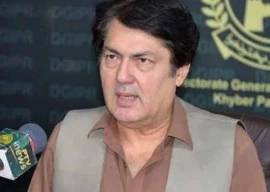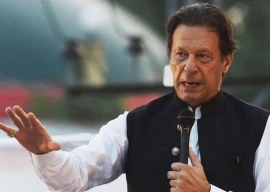
Hina’s suffering is painful to watch, but it is the reality that thousands of flood victims in Khyber-Pakhtunkhwa face everyday. Saeed Wali Shah and his family are residents of Choki Drab, a village in Pabbi near Peshawar. The family was forced to flee when rising flood waters washed their home away. They now live in a relief camp set up at the Degree College in Pabbi. Families in this relief camp are the ‘unlucky’ victims of the floods — their camp has been abandoned by aid workers after a scuffle with the local administration.
Shah says doctors in the camp gave his daughter medicine for diarrhoea but it didn’t have any effect on her. He had to sell some salvaged kitchen utensils to collect enough money to take Hina to a private clinic, where an injection costs Rs140 — a huge amount for the small family. “She is better now,”he says with relief.
The foetid air in Hina’s room makes it impossible to breathe. She shares living space with 45 people, including 20 other sickly children. “The children’s heads were covered with boils and their bodies were full of blisters,” says Samina Bibi, who is in her 60s. “The filthy water caused this” she explains.
Conditions in the overcrowded relief camp, which houses 150 families, have only added to the miseries of the flood victims. The state of affairs in this camp mirrors the situation across Khyber-Pakhtunkhwa. Information from the Provincial Disaster Management
Authority (PDMA) reveals that approximately 25,234,144 people have been affected by floods in Khyber-Pakhtunkhwa. The lack of medical care means that the province could suffer more in the aftermath of the floods than it did during the initial disaster.
Statistics reveal that 172,868 people — 32 per cent of the population in areas affected by floods in Khyber-Pakhtunkhwa — need food on an immediate basis. 270,472 people do not have access to clean drinking water while 162,017 people lack hygiene facilities.
3,095,162 people or 81 per cent of the affected population do not have access to essential medication whereas 85 per cent of affected people cannot access anti-cholera medication.
Extensive damage to basic infrastructure in the province means that many areas like Shangla, Kohistan, parts of Upper Dir and the Northern areas have become inaccessible.
Around 74,521 kilometres of the area in which relief operations need to be carried out consists of mountainous, rugged terrain. Around 2,000 kilometres of roads in this area have been destroyed. Over 800 educational and 139 health facilities have also been destroyed.
Cholera: the threat of a deadly epidemic
Flood victims may have another disaster to contend with soon if this situation continues much longer — an outbreak of cholera.
Cholera is a deadly intestinal infection that can cause death if left untreated. According to an update released by the NDMA on August 26, only 149 cholera kits have been distributed in one province — the Punjab.
Given that 1,300 cases of acute diarrhoea have been registered in areas such as Hangu alone, the distribution of cholera medication is far from adequate.
Worryingly, Dr Muhammad Ishaq Bangash, the Executive District Officer (EDO) Health in Hangu, says that “1,370 cases of cholera have been registered in the district”. Salehdin, a resident of Hangu, says: “The epidemic is spreading fast — and there are hardly any medicines at the hospital.”
According to a World Health Organisation (WHO) official, 18 cholera treatment centres will be set up in the province. However, if cholera spreads as an epidemic, it shall have severe consequences for the whole country.
According to the WHO, “in addition to human suffering, cholera outbreaks cause panic, disrupt social and economic structures and can impede development. Unjustified panic-induced reactions by other countries include curtailing or restricting travel from countries where cholera outbreak is occurring, or import restrictions on certain foods. For example, the cholera outbreak in Peru in 1991 cost the country $770 million due to food trade embargoes and adverse effects on tourism.”
Unfortunately, even basic medicines are in short supply in relief camps. According to a highly-ranked official from the WHO,“The provincial
government lacks an alternative plan as thousands of people from the flood-hit areas are still left without essential medicinal facilities.”
Most medicines being supplied have been provided by the WHO and some small NGOs. The official warns that medicines could fall short because the supply was originally meant for people who had been displaced as a result of the military operation.
However, Dr Ziaul Hasnain, Provicial Coordinator for the
Emergency Cell of the province’s Health Department says: “We are searching for alternatives — several foreign aid agencies have asked for our demands.”
It is clear that the government and medical authorities don’t see eye to eye when it comes to medical supplies.
PDMA spokesperson Adnan Khan says, “The government has provided the necessary funds to the District Coordination Officers of the respective districts on the basis of the assessed damage and population. Now it is their task to buy medicines.”
But Dr Abdul Malik Shah at Nowshera’s District Headquarter Hospital is not satisfied with the supply of medicines. “The problems may subside to some extent only if medicines that are provided by the WHO are given to the patients. But this does not happen”. According to Shah, most medicines being sold over the counter to flood victims are fake — and have no affect on the diseases they claim to cure.
For people like Saeed Wali Shah, the situation becomes more helpless everyday. Shah’s three-year-old son Hamza — whose eyes are bloodshot because of conjunctivitis — sits in his lap. Hamza’s right hand is attached to a catheter while two fingers of his other hand are bandaged. Pointing towards the water pump at the camp, which is thronged by children waiting to drink, Wali says, “First, it was the water that infected my child with acute diarrhoea. Then he lost the tip of his finger while filling water from this pump.”
Barely able to speak, he is a man defeated. “When the floods first washed away my house, I thought, ‘We have a government and people will come to help us’. I can’t comprehend this — why has everyone forsaken us?”
Published in The Express Tribune, September 5th, 2010.





1725254039-0/Untitled-design-(24)1725254039-0-270x192.webp)
1732189200-0/Express-Tribune-(13)1732189200-0-270x192.webp)



1732186994-0/Untitled-design-(10)1732186994-0-270x192.webp)






COMMENTS
Comments are moderated and generally will be posted if they are on-topic and not abusive.
For more information, please see our Comments FAQ